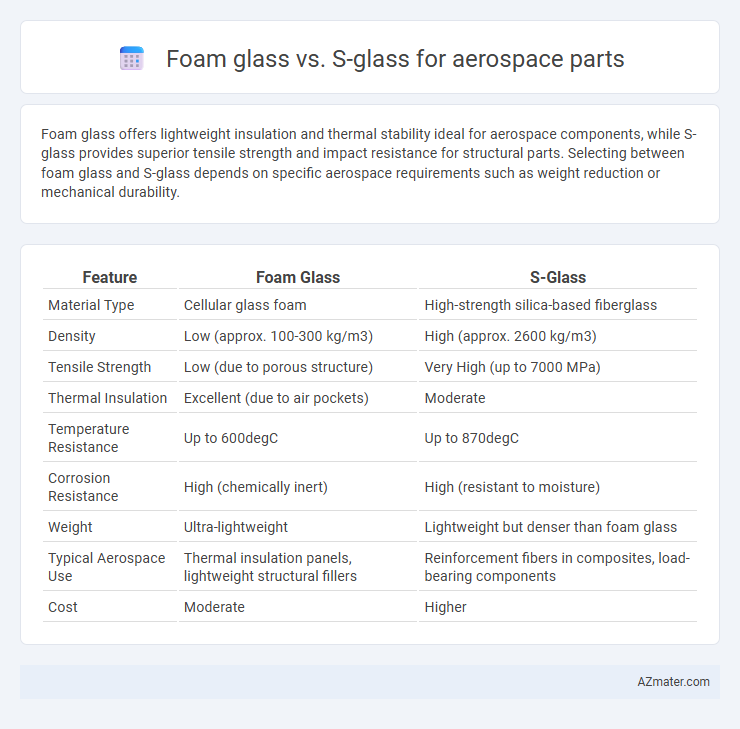Foam glass offers lightweight insulation and thermal stability ideal for aerospace components, while S-glass provides superior tensile strength and impact resistance for structural parts. Selecting between foam glass and S-glass depends on specific aerospace requirements such as weight reduction or mechanical durability.
Table of Comparison
| Feature | Foam Glass | S-Glass |
|---|---|---|
| Material Type | Cellular glass foam | High-strength silica-based fiberglass |
| Density | Low (approx. 100-300 kg/m3) | High (approx. 2600 kg/m3) |
| Tensile Strength | Low (due to porous structure) | Very High (up to 7000 MPa) |
| Thermal Insulation | Excellent (due to air pockets) | Moderate |
| Temperature Resistance | Up to 600degC | Up to 870degC |
| Corrosion Resistance | High (chemically inert) | High (resistant to moisture) |
| Weight | Ultra-lightweight | Lightweight but denser than foam glass |
| Typical Aerospace Use | Thermal insulation panels, lightweight structural fillers | Reinforcement fibers in composites, load-bearing components |
| Cost | Moderate | Higher |
Introduction to Advanced Glass Materials in Aerospace
Foam glass and S-glass represent advanced glass materials utilized in aerospace for their unique structural and thermal properties. Foam glass offers lightweight insulation with excellent thermal resistance, making it suitable for applications requiring thermal management and vibration damping. S-glass, a high-strength fiberglass, delivers superior tensile strength and impact resistance critical for load-bearing aerospace components, enhancing durability and safety in extreme conditions.
Overview of Foam Glass: Composition and Properties
Foam glass is a lightweight, cellular material made from crushed glass combined with foaming agents, resulting in a rigid structure with excellent thermal insulation and high compressive strength. Its closed-cell composition provides superior resistance to moisture, fire, and chemical corrosion, making it an ideal candidate for aerospace applications requiring durability and thermal stability. Compared to S-glass, which is a high-strength fiberglass used primarily for its tensile properties, foam glass excels in insulation and structural support where weight reduction and environmental resistance are critical.
S-Glass: Structure, Strength, and Applications
S-Glass, a high-strength alumino-silicate glass fiber, exhibits superior tensile strength and stiffness compared to conventional E-glass, due to its optimized silica and alumina content that enhances structural integrity. Its exceptional strength-to-weight ratio and excellent thermal stability make S-Glass ideal for critical aerospace components such as fuselage reinforcements, wing skins, and engine casings where durability and resistance to thermal shock are paramount. Foam glass, although lightweight and insulating, lacks the mechanical strength and rigidity required for load-bearing aerospace applications, positioning S-Glass as the preferred choice for structural aerospace parts demanding high performance and reliability.
Comparative Weight Analysis: Foam Glass vs S-Glass
Foam glass demonstrates a significantly lower density, typically around 0.2 to 0.5 g/cm3, compared to S-glass fiber's density of approximately 2.49 g/cm3, resulting in substantial weight savings for aerospace components. The lightweight nature of foam glass enhances fuel efficiency and payload capacity, while S-glass offers superior tensile strength and impact resistance despite its heavier mass. Engineers must balance the lower mass benefits of foam glass with the mechanical durability of S-glass when selecting materials for aerospace structural parts.
Thermal Performance in Aerospace Environments
Foam glass exhibits exceptional thermal insulation properties due to its cellular structure, providing low thermal conductivity and resistance to high temperatures, making it ideal for aerospace applications requiring lightweight and effective thermal barriers. S-glass, known for its superior tensile strength and thermal stability, offers excellent resistance to thermal shock and maintains mechanical integrity under rapid temperature fluctuations in aerospace environments. When comparing thermal performance, foam glass excels in insulation efficiency while S-glass provides durability and thermal resilience, critical for aerospace parts exposed to extreme thermal cycles.
Mechanical Strength and Durability Comparison
Foam glass exhibits excellent compressive strength and thermal insulation but falls short in tensile strength and impact resistance compared to S-glass, which is engineered with high tensile strength and superior fracture toughness ideal for aerospace structural components. S-glass offers exceptional durability under cyclic loading and environmental stress, significantly outperforming foam glass in fatigue resistance and long-term mechanical stability. The choice between foam glass and S-glass hinges on the specific aerospace application requirements for load-bearing capacity and durability in harsh operational environments.
Insulation and Vibration Damping Capabilities
Foam glass exhibits superior thermal insulation due to its closed-cell structure, providing effective temperature regulation in aerospace components. S-glass fibers deliver exceptional vibration damping by combining high tensile strength with excellent impact resistance, crucial for dynamic aerospace environments. Choosing between foam glass and S-glass depends on prioritizing thermal insulation or mechanical vibration control in aerospace part design.
Resistance to Chemical and Environmental Stressors
Foam glass offers exceptional resistance to chemical corrosion and environmental stressors due to its inert, non-porous structure, making it highly resistant to acids, alkalis, and moisture commonly encountered in aerospace applications. S-glass, a high-strength fiberglass material, provides excellent environmental durability with superior resistance to moisture absorption, UV radiation, and chemical exposure, ensuring long-term integrity under harsh aerospace conditions. Both materials deliver robust protection, but foam glass excels in chemical inertness, while S-glass offers enhanced mechanical strength combined with environmental resilience.
Cost and Manufacturability Considerations
Foam glass offers lower material costs and easier machinability compared to S-glass, making it more cost-effective for certain aerospace applications requiring lightweight insulation. S-glass, while more expensive, provides superior tensile strength and thermal resistance, but its complex manufacturing process involving continuous fiber weaving increases production costs and lead times. Choosing between foam glass and S-glass depends on balancing budget constraints with performance requirements and fabrication capabilities in aerospace part production.
Selecting the Optimal Glass Material for Aerospace Parts
Foam glass provides lightweight insulation and superior thermal resistance, making it ideal for aerospace applications requiring high temperature stability and vibration damping. S-glass offers exceptional tensile strength and impact resistance, which enhances structural integrity in high-stress aerospace components. Selecting the optimal glass material depends on balancing thermal insulation needs with mechanical strength requirements specific to the part's operational environment.

Infographic: Foam glass vs S-glass for Aerospace part
 azmater.com
azmater.com